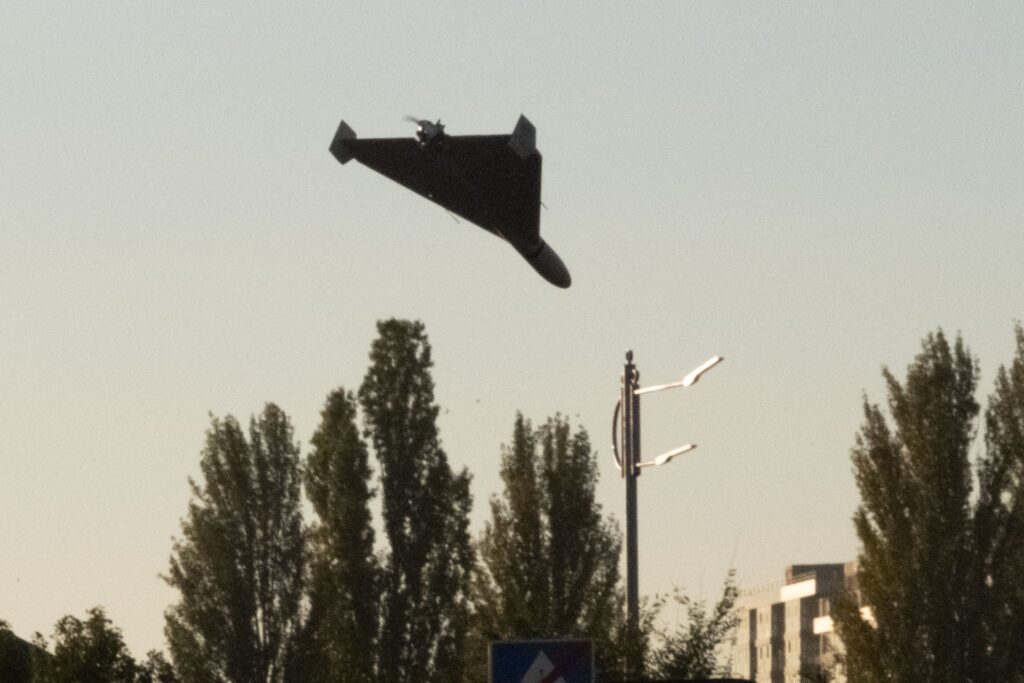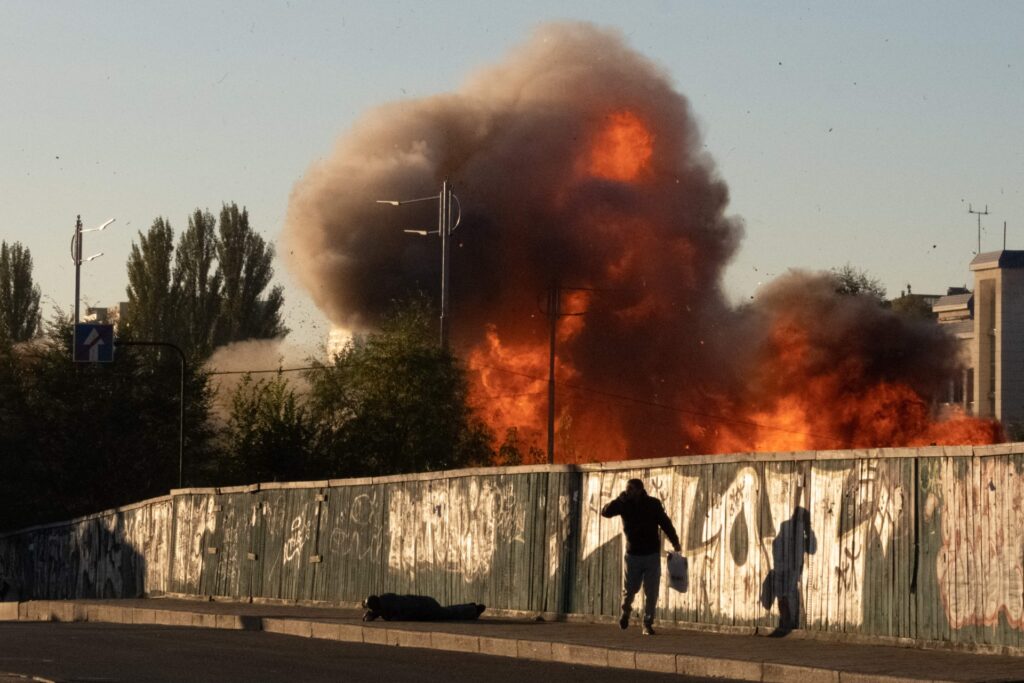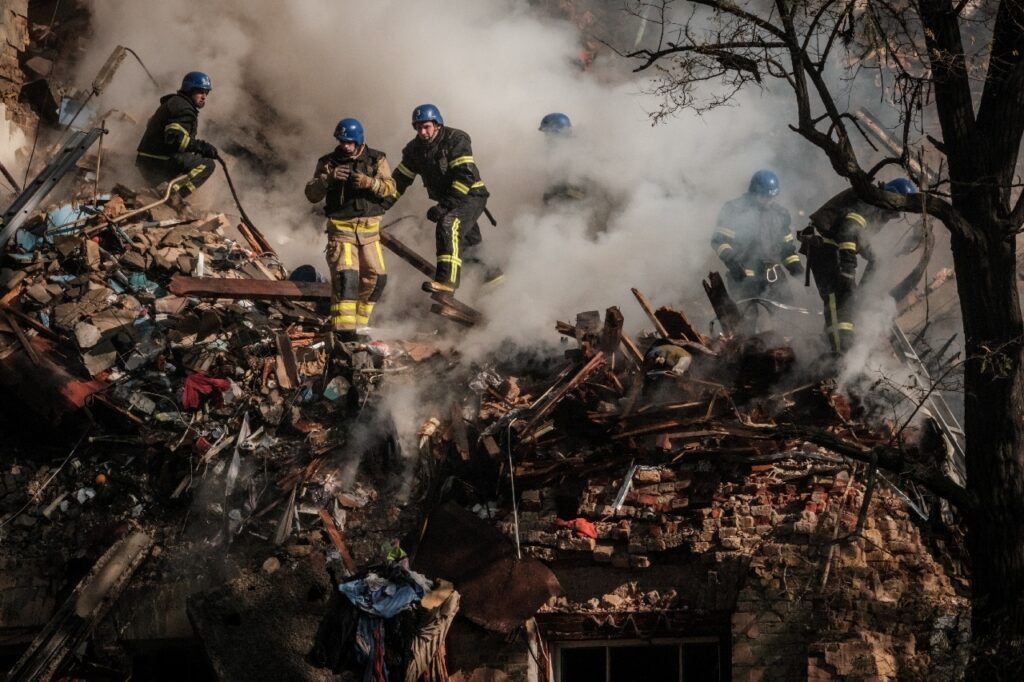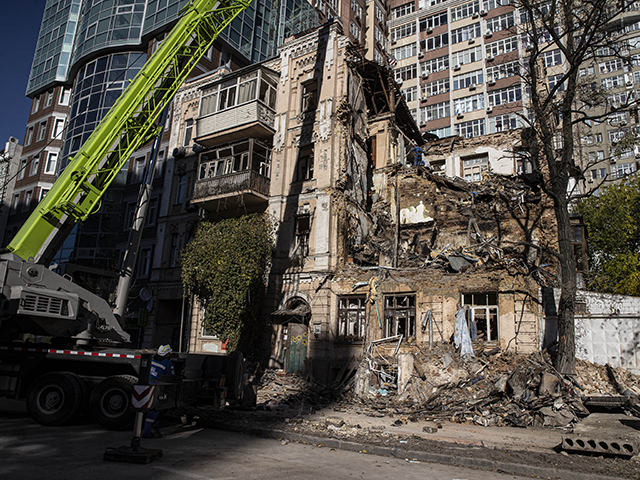Kremlin spokesman Dmitry Peskov on Tuesday denied reports that Russian forces are using Iranian-made drones as part of their intense bombing campaign in Ukraine.
Contrary to Peskov’s denials, international journalists clearly photographed Iranian drones attacking civilian targets in Ukraine on Monday.
“No, we do not have such information. The hardware that is used is Russian. You know that. It has Russian names. You can address all other questions to the Defense Ministry. No, we do not have such information,” a flustered Peskov insisted when reporters asked about the Iranian drones.
Western intelligence agencies reported in July that Russia was looking to purchase unmanned aerial vehicles (UAVs) from Iran to replenish stocks depleted in the early months of the Ukraine invasion. Satellite photos caught Russian officials examining Iranian UAVs on an airfield near Tehran.

A drone approaches for an attack in Kyiv on October 17, 2022, amid the Russian invasion of Ukraine. (YASUYOSHI CHIBA/AFP via Getty Images)
Intelligence reports said the first Russian transport planes loaded with Iranian drones arrived on the front lines in Ukraine by late August. According to these reports, Russian troops encountered some technical difficulties with the Iranian weapons which delayed their battlefield deployment.

A man falls on the ground following a drone attack in Kyiv on October 17, 2022, amid the Russian invasion of Ukraine. (YASUYOSHI CHIBA/AFP via Getty Images)
A senior Ukrainian official told the New York Times (NYT) last week that Israel was providing Ukraine with intelligence on Russia’s use of Iranian-built “suicide drones.” The Ukrainian official said these drones were proving to be slow and “easy to target,” so Ukrainian forces were able to shoot dozens of them down.

Firefighters conduct work in a destroyed building after the Russian drone attacks in Kyiv, Ukraine on October 17, 2022. (Metin Aktas/Anadolu Agency via Getty Images)
The Ukrainian presidential office said last week that Iranian-made drones were part of Russia’s intense missile attacks against “critical infrastructure” in Ukraine.

Ukrainian firefighters extinguish the smoldering rubble of a building hit in a drone attack in Kyiv on October 17, 2022. (AFP)
On Sunday, Ukrainian military sources told the UK Daily Mirror that up to 50 members of Iran’s elite Islamic Revolutionary Guard Corps (IRGC) were on the ground in Ukraine, teaching Russian troops how to operate the Shahed-136 suicide drones — and occasionally handling operations themselves for crucial strike missions.
The Daily Mirror’s sources claimed Ukrainian forces were able to destroy at least one Shahed-136 base, and IRGC operatives were “actively being hunted down.”
Ukrainian sources also claimed IRGC instructors are based in Russian-occupied Crimea and have directly overseen drone strikes against Ukrainian civilian targets.
On Monday morning, a journalist for Agence France-Presse (AFP) photographed an Iranian-built Shahed-136 drone loaded with explosives attacking a target in Kyiv. This is most likely the development that left Peskov so visibly rattled at his Kremlin press conference on Tuesday morning:
Kyiv mayor Vitaly Klitschko said 28 drones were launched against his city on Monday. Many were intercepted by Ukrainian troops and fighter jets, but five strikes inflicted damage on targets including an energy utility company, a municipal heating station, and an apartment building. At least four people were killed, one of them a pregnant woman recovered from the wreckage of the residential building.
The Russian Defense Ministry claimed it used “high-precision air- and sea-based weapons” and struck only “military targets and energy infrastructure.” One of the strikes cut external power to the much-abused Zaporizhzhia nuclear power plant, which was fortunately able to keep its safety systems running with backup diesel power.
The U.S. State Department referenced the above footage on Monday as part of the “extensive proof” that Russia is using Iranian drones “against both military and civilian targets.” The White House accused both Moscow and Tehran of lying when they denied Iranian drones were being used in Ukraine.
The U.S. concurred with the U.K. and France that Iranian drone sales to Russia would violate U.N. Security Council resolutions that were part of the 2015 Iran nuclear deal. Some of the arms controls on Iran expired in 2020 despite efforts by former U.S. President Donald Trump to extend them, but the ban on missile technology that would include UAVs remains in effect until October 2023.

COMMENTS
Please let us know if you're having issues with commenting.